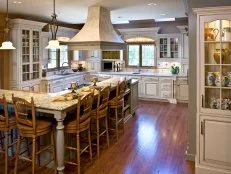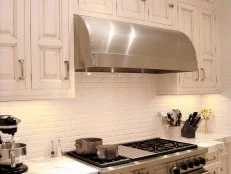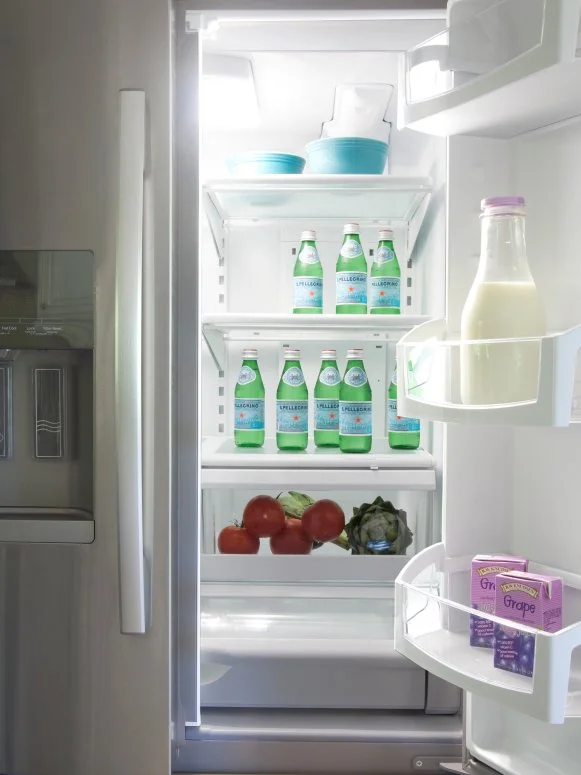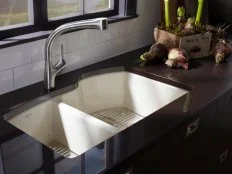Appliances, alone, do not make a kitchen. But, they just might be the most important aspect of your space. After all, the kitchen’s primary function is for preparing and cooking meals.
How high-end do you want to go? Chefs and bakers who plan to use the restaurant-quality features on professional models can justify hefty price tags that can consume their kitchen budget.
On the other hand, if you like the look of the professional-grade range and built-in refrigeration units, and those dramatic (and highly effective) hoods for ventilation, you can have your cake and eat it, too. With many mid-range and high-end (but within reach) appliances on the market today, you can get the looks and quality performance without shelling out for the high-high end models. So seriously consider how much of your budget you want to spend on appliances.
Ideally, you should choose your kitchen layout first, then choose appliances that fit. If you fall in love with a side-by-side fridge, will you have room for two wall ovens and a cooktop? See, there are compromises.
Choosing Appliances
Cooktops. Gas, electric or induction? The choice is personal, though you don’t often hear of people who go from gas to electric. When choosing a cooktop for performance, consider efficiency: how much heat do you lose from burner to pan? With gas, you lose about 40 percent, says Nancy Divita, showroom manager at Trevarrow Inc. On the other hand, with induction heat—a flat cookstop like electric that performs like fast-heating gas stoves—you lose the least amount of heat. Induction isn’t mainstream, but it’s making a return in the American market now, Divita says. “Induction is certainly a time-saver because you can bring a pan of water to boiling faster than you can on a high-performing BTU (gas) range top,” Divita says.
When shopping for gas cooktops, ask about BTU, which stands for british thermal units, a measurement of energy content. Serious ranges are 9,200 BTU and up. Ask about variable control, meaning how long can you maintain “simmer” without the flame going out. Look for burner grates made of cast iron or a metal that conducts heat for better heat transfer from the burner to the pan.
Ovens. A high-performing convection oven, which circulates heat with a fan to cook food faster and more evenly, will help you get dinner on the table faster than a traditional oven. Bakers, on the other hand, will want the traditional bake/roast/broil. In a perfect kitchen world, you can have both with a stacked or side-by-side oven station.
Range hoods. A serious cooktop demands a ventilation system that will usher exhaust out of the kitchen without sounding like a Cessna is landing at your dinner party. If you hear the sound of suction (and not the motor running), this is a good thing. If noise bothers you completely, consider units that can be installed with exterior motors. (You can build housing for these so they blend somewhat with your home’s façade.)
Stylish Kitchen Hood Treatments



Exterior blowers and inline blowers provide high-performance ventilation. As for those recirculating fans in economy oven-range-microwave stacks: “You might take out some of the fat, but you’re not moving out any of the heat,” Divita says. Choose a hood with adequate cfms for your cooktop. As a general rule, a four-burner electric cooking surface should have ventilation that performs at 400 cfms.
Of course, there’s more to the hood than blowing out hot air, even if that’s the key function. Hoods are focal points in some kitchen designs, and they are available in designs from linear-modern to majestic-traditional, and in materials from stainless steel to glass.

Consider space, features and budget when shopping for a fridge for your kitchen remodel.
Refrigerators/Freezers. Freestanding models slide into a space and generally stick out 6 or 7 inches beyond counter depth (24 inches standard). But you can purchase counter-depth refrigerator/freezers that will look like built-in units. When evaluating refrigerator performance, quality comes down to the compressor. Single-compressor units that power a refrigerator-freezer work double-time to keep a moist fridge and a dry, cold freezer. A dual-compressor unit costs more but will allow you to keep fresh food longer. This might be worth it if you pay a lot for groceries. “People who are buying organic and better-quality products want them to be peak because they paid for organic or gourmet foods,” Divita says. “You want to get your money’s worth.”
As for configuration, French-door models are popular, as are French-door refrigerator (on top) with freezer drawer (on bottom). Units might have two side-by-side freezer drawer, or a refrigerator drawer that is accessible to children. The ideal (and most expensive) situation is completely separate refrigerator and freezer units.
Concerning water/ice in the door, people are more focused on purification of water these days, Divita says. Some units will accomplish this. Others simply pass water through the copper pipe in the unit and out your refrigerator door.
Microwaves. Microwaves can consume a lot of space no matter where you put them: on the counter, built in to cabinetry or above a cooktop. So if you want your microwave to work twice as hard for you, consider a convection microwave that also works as a fast-speed oven, eliminating the need to purchase a double oven. Also available are microwave drawers, which are handy and nestle among base cabinets.
Dishwashers. Now you can get drawer dishwashers, which are easier to load and can be installed at various heights based on your needs Plus, they can handle smaller loads, so they are more efficient. Still, traditional dishwashers with doors that pull from the top down are the most popular style, and they can be paneled to blend with the cabinetry for a seamless look. Stainless steel still reigns in popularity. Depending on your kitchen layout, you might want to add an economy-sized dishwasher by a wet bar to manage glassware.
Sinks. The sink is an after-thought in some kitchens, but it’s a good idea to choose one at the same time you choose cabinetry for underneath the sink area for a seamless look. If you opt for an undermount style, the sink is generally installed before the countertops, so plan for that. Don’t skimp on the sink if you splurged on a gorgeous countertop. If the sink has to be replaced prematurely, a contractor might have to lift up the entire countertop of an undermount sink—a costly and messy job.
Sinks come in a variety of depths, shapes, sizes and colors. They are designed with cutting boards and more. Materials include stainless steel, enameled cast iron, composite acrylic and fiberglass, quartz and solid surface. Of course, there’s more to the hood than blowing out hot air, even if that’s the key function. Hoods are focal points in some kitchen designs, and they are available in designs from linear-modern to majestic-traditional, and in materials from stainless steel to glass.
Consider how you use the sink before you make this purchase. Do you like to prep and clean dishes in the same space? (If not, perhaps you need a separate prep sink.) How deep do you want the bowl? How tall are you, and what sort of reachability is necessary?
Kitchen Sink Styles and Trends



Warming Drawers. These are especially convenient for the entertainer, but every household can benefit from a warming drawer that is properly utilized (meaning for more than taking the chill off of plates before serving). Warming drawers allow you to prepare food in advance and serve it all at the same time. They allow food to maintain moisture while staying warm, which is a preferable alternative to reheating lukewarm side dishes in a microwave, which will break down the molecular structure of the food. Real chefs want a warming drawer. And family cooks will fall in love with the convenience.
Finishes. Now that you’ve considered your appliances, think about finish. Stainless steel is standard and rated by gauge. Appliances range from 8- to 30-gauge steel. The higher the gauge, the more slick and sleek and shiny the surface. This means it’s better quality, easier to clean, more durable and will last longer.
Higher grades of stainless steel look smooth and less “brushed.” Lower grades are more gray in color and have a grainier texture vs. the silver shiny surface of a higher-grade steel. That’s because the higher grade has a greater ration of nickel to chromium, which retains luster for longer and is more durable.
Helpful Tips
Keep these tips in mind when considering appliances:
- When choosing a convection oven, keep in mind that electric convection ovens tend to perform more effectively. Ask the showroom manager about this.
- Sometimes a hood is a focal point in the kitchens, and sometimes not. Consider a glass hood that will not block views if the hood is positioned over an island/eating space or interferes with an important sight line.
- Want to hide the refrigerator/freezer? Check into models that can be covered with paneling so this appliance blends in with cabinetry.
- Considering a prep sink or bar sink? Size matters. Invest in a true sink for food preparation. A deeper sink is more convenient for washing heads of romaine lettuce and other vegetables. A pint-sized bar sink is great for rinsing out glasses.
